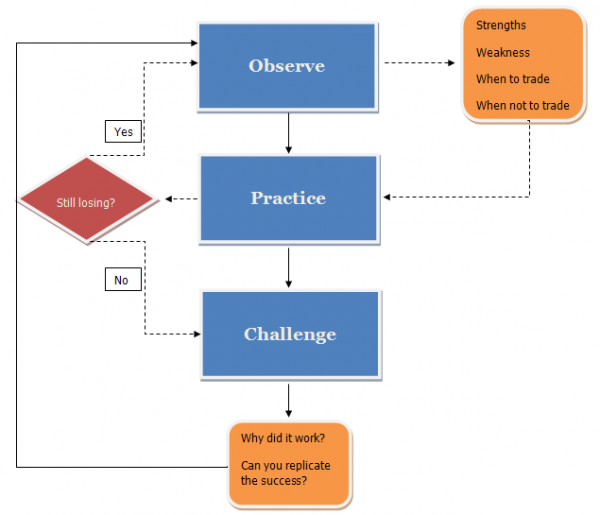Simplicity is best in just about anything, but as humans making things complex is what we do best. Forex trading is no different either. What could be simpler than buying low and selling high? Instead, what we have are tons of indicators, complex variables, all in an effort do the simple thing, buying low selling high. It is easy to get lost in the complexity that at times we miss the most obvious.
Here’s a thought: On trading forums, we often find traders writing and explaining their trading strategy. But, despite all the information they share, isn’t it strange that nearly half the traders or more who follow the strategy still end up losing money?
Some of the common reasons we find, that seems to justify why traders fail to make money with a strategy that is successful for one trader is because:
- The trading strategy no longer works because the markets have changed
- The trading strategy works only at a certain time and only for a certain instrument
The real reason is in fact:
- You haven’t spent much time analyzing the strategy
- You haven’t practiced the strategy enough
Sure, there can be instances where the trading strategy presented does indeed require more improvements, but broadly speaking, even the most successful strategies outline do not stick well with most traders.
So how can you, as a trader improve your trading, regardless of how simple or complex your strategy may be?
Observe
Observation is a great tool
You can tell a lot about what is happening in the markets by simply observing the markets. No trading, but just eyeballing the charts using the strategy rules and indicators. Observation can be a great tool but one that is seldom used. For a trader, the best place to start is to load their strategy templates and simply sit back and observe. Most importantly, looking at the price charts and taking notes on what price could do, based on your strategy rules can be a great way to look back to your notes and figure out what happened in the markets.
If moving average crossovers are your forte, then instead of trying to build an EA or scalping the markets, take a few days and simply watch the charts. You don’t need to sit in front of your charts all day long, but simply make notes on what you think the price will do. The minor details such as pull backs in the trend, the price targets, and invalidation levels can greatly help to improve your trading odds.
This seemingly boring job can actually do wonders for your trading. A conscious effort made to put this into practice will automatically tune your mind to watch for potential opportunities as well as warning signs when you are actually trading.
Practice
Practice makes you perfect
And this couldn’t be further from the truth in trading. By practice, we are not talking about a ‘demo trading account’ where you blindly buy and sell based on the strategy rules.
Practice is, in fact, the next step in your trading journey. Based on the information that you gathered by observing the charts and putting this knowledge into practice can help you to form a habit.
Practicing your trading strategy over and over again can be a great way to improve your trading skills. More importantly, this repetitive process will also help you to identify some minor yet important details that price can offer you. These minor details are what can be the differing variable between a winning and a losing trade.
Challenge yourself
Once you stop learning, you start dying
Or in the trading context, once you stop learning your strategy starts to fall apart.
So far, you have observed the markets, and you have started practicing. But that is not the end. The real game changer comes in this next part which is to challenge yourself. But how does one go about doing this?
There are many forums, websites, and resources nowadays with many traders/bloggers posting their own charts. The first step is to find a trader who uses the same strategy such as yours. It could be a simple moving average crossover or a Bollinger Band strategy. The point is, once you narrow down to a few traders who keep updating their charts and writing their analysis, you can then use these very charts, figure out how price action unfolded and then challenge yourself as to whether you would have taken that trade or if you would have done it differently.
Nowadays, most traders end up arguing on whose analysis is right. An argument doesn’t increase your trading capital at the end of the day. Learning does!
So instead of arguing with a trader, who thinks the price is going to move in their favor, take a step back, wait for the price to evolve, then look back at those charts and determine if the trader was right or wrong. If he was right, try to understand how the trade worked out. If he was wrong, figure out why he was wrong and if you could have done things differently.














